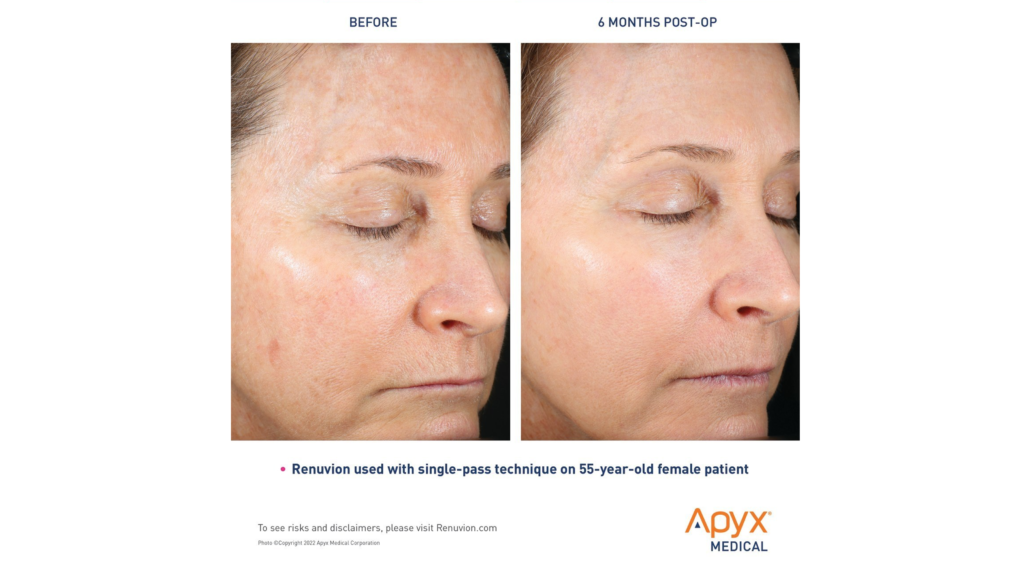ApyxMedical announced the 510(k) FDA Clearance of their Renuvion dermal handpiece for the treatment of moderate to severe wrinkles and rhytids, limited to patients with Fitzpatrick Skin Types I, II or III. Photo courtesy of Apyx Medical Corporation: Renuvion used with a single-pass technique on a 55-year-old female patient.
Everyone’s face changes with age, but due to constant innovations in technology, people can seek out options to slow or reverse the appearance of the process of aging. Common anti-aging procedures include Botox or dermal fillers, which can reduce the appearance of wrinkles, sagging and increase volume in the face where desired. Facelifts are also an option for a more dramatic change, however the procedure itself is rather invasive and patients risk the possibility of appearing less “natural.”
Apyx Medical Corporation announced the 510(k) FDA clearance of their Renuvion® Dermal handpiece for the treatment of moderate to severe wrinkles and rhytids (fine lines), limited to patients with Fitzpatrick Skin Types I, II or III. Renuvion is Apyx Medical’s proprietary helium plasma and radiofrequency technology, and the facial renewal device uses the same technology that has been long used in the plastic surgery space. This option is an effective, non-invasive tool used to smooth and contract skin and rejuvenate the face in a way that does not risk looking unnatural.
Demonstrating Efficacy in a Clinical Study
Laser and energy-based treatments have been used in rejuvenation procedures for years, but the search for effective treatments with less downtime, side effects and efficacy for all skin types continues.
Nitrogen plasma has previously been used in skin regeneration, and helium plasma is a novel alternative. Plasma is a gas in a temporarily higher energy state — the electrons have transitioned to higher orbits, and the higher energy state dissipates quickly without requiring more energy. The use of helium gas plasma in facial rejuvenation entails heating the surface of the skin with the heat transfer from the flowing plasma in a controlled, bimodal manner.
A preclinical study compared the effects of helium plasma to nitrogen plasma in a porcine animal model — the helium plasma resulted in more superficial thermal effect (less tissue injury), greater skin contraction and ultimately similar histopathological findings to the nitrogen gas option.
XTALKS WEBINAR: Diversity and Inclusion in Clinical Trials — Practical Steps for Patient Recruitment Strategies
Live and On-Demand: Wednesday, August 10, 2022, at 11am EDT (4pm BST)
Register for this free webinar to learn about the practical steps to be taken towards diversity and inclusion in clinical trials. Attendees will learn about the new US Food and Drug Administration (FDA) guidance and elements of a diversity plan. The featured speakers will discuss Important factors to consider when evaluating potential site and patient recruitment vendors from the diversity perspective.
A clinical trial published in April 2020 subsequently evaluated the efficacy and safety of the novel Renuvion helium plasma device for dermal resurfacing. The trial included 55 subjects over the age of 30 with a wrinkle score of ≥2 on the Fitzpatrick Wrinkle and Elastosis Scale (FWS) and a Fitzpatrick Skin Scale score of ≤III.
Most subjects underwent a treatment of the whole face, where the device’s power was limited to 20 percent around more delicate mouth and eye areas.
Three months post-treatment, their FWS scores were compared with baseline scores that were determined by both blinded independent photographic reviewers (IPRs) and the study’s investigators.
Even at the lower power level used in the study, significant improvements were noted by IPRs and investigators in the subjects from a single pass of the helium plasma treatment. Overall, 90.9 percent of subjects said they saw improvements using the modified Global Aesthetic Improvement Scale. The study investigators noted a ≥1 point FWS improvement in approximately 90 percent of subjects while the blinded IPRs saw improvement in only 63.64 percent of subjects — however, the discrepancy in reporting is likely due to the IPRs looking at 2D photos rather than in-person examination of subjects. No serious adverse events were reported with the treatment.
Future Directions for Renuvion
Renuvion enables dermatologists to provide transformative results for their patients in a non-invasive manner.
Oculoplastic surgeon Dr. Tabasum Mir states that “Renuvion for facial procedures is ground-breaking. It’s a treatment that fulfills a big unmet need in cosmetic procedures,” citing noteworthy results seen firsthand in patients.
As with all cosmetic procedures, there are some risks associated with the use of the Renuvion Dermal handpiece. Potential risks include hypertrophic scarring, milia or acne, spider veins, skin discoloration, reactivation of dormant infections, infection, bruising, or bleeding.
Although the FDA clearance of the device is one of the first significant developments in many years for skin rejuvenation, the use of the Renuvion Dermal handpiece is limited to patients with the Fitzpatrick skin types I, II and III. Further investigation is needed to determine the safety and effectiveness of higher energy levels and multiple passes of the device as well.












Join or login to leave a comment
JOIN LOGIN